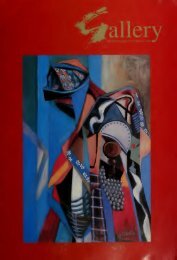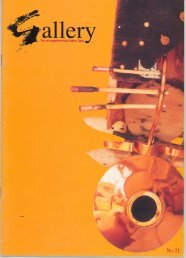Gallery : the art magazine from Gallery Delta
Gallery : the art magazine from Gallery Delta
Gallery : the art magazine from Gallery Delta
Create successful ePaper yourself
Turn your PDF publications into a flip-book with our unique Google optimized e-Paper software.
Zimbabwean context, <strong>the</strong> parallel between<br />
Original Sin and colonisation is clear. But<br />
does this assume that colonisation, like sin,<br />
was pre-ordained, a miserable /«/7 accompUl<br />
Or that a post-independent <strong>art</strong>ist is forced to<br />
come to terms with <strong>the</strong> fact of history?<br />
Whe<strong>the</strong>r <strong>the</strong> <strong>art</strong>ist's battle is with <strong>the</strong> stain of<br />
sin or with <strong>the</strong> taint of colonisation or both,<br />
work changes everything. What <strong>the</strong> <strong>art</strong>ist<br />
imagines can be restored of <strong>the</strong> pre-<br />
colonised self is transformed by <strong>the</strong> act of<br />
seeking. Thus. Witikani is not painting a<br />
traditional hut in a field of grass. He paints<br />
what later you see is a hut. <strong>from</strong> <strong>the</strong> path as<br />
he walks, <strong>from</strong> his point of view, at a pace<br />
that feels rhythmic and right. Like <strong>the</strong> o<strong>the</strong>r<br />
painters in this disparate group, his work<br />
represents a return to self, one that is not<br />
burdened by <strong>the</strong> screech and trauma of an<br />
outsider's view of <strong>the</strong> colonised. The<br />
painters, like Witikani. are making no claims<br />
for a dramatic return to tradition or<br />
bottomline spiritual virtues espoused by a<br />
body of male sculptors. In many ways, <strong>the</strong>se<br />
painters cling to <strong>the</strong> little values, honest<br />
assessments, understatements, a feminine<br />
principle that stresses tiny bursts of light and<br />
emotion — <strong>the</strong> miracle of re-inventing self.<br />
These painters, much more than <strong>the</strong><br />
sculptors who are famous, are overthrowing<br />
<strong>the</strong> dominant creeds and overweening<br />
teleologies of our times. And <strong>the</strong>y are doing<br />
it right in front of our eyes.<br />
They struggle against censorious attitudes,<br />
disbelieving families and <strong>the</strong>ir own fear of<br />
stalling before expression has taken shape.<br />
Miraculously — and this has only happened<br />
in <strong>the</strong> last two years — this bunch of <strong>art</strong>ists<br />
has begun to get away <strong>from</strong> us. <strong>from</strong><br />
<strong>the</strong>mselves. The emergency <strong>art</strong>ists are up<br />
and running and flouting <strong>the</strong> rules of <strong>the</strong><br />
road.<br />
Ishmael Wilfred is an <strong>art</strong>ist who goes his<br />
own way. He pays no heed to rules of form<br />
or line or composition. Yet his own<br />
combination is often bewildering and quite<br />
brilliant. Wilfred obeys <strong>the</strong> voice <strong>from</strong><br />
within. Difficult to comprehend <strong>from</strong> <strong>the</strong><br />
outside, his works are luminous tales of<br />
survival. Riding, with its strutting,<br />
triumphant riders has <strong>the</strong> exuberant quality<br />
of jockeys in a race but it is only when you<br />
see <strong>the</strong>m as witches on hyena-back that <strong>the</strong>y<br />
become witty, dangerous flyers. Wilfred's<br />
taste for <strong>the</strong> ghoulish comes straight out of<br />
dreams. Cannibal After a Head is <strong>the</strong><br />
painter's fascination for a story he read in<br />
<strong>the</strong> paper. There is a sense of interpretation<br />
here. But in Two Tokoloshe — where he<br />
struggles with form to quell <strong>the</strong> demons of<br />
<strong>the</strong> night — and in Red Cat. which is a one-<br />
on-one battle with life and consciousness,<br />
Wilfred engages his dreams.<br />
Red Cat was a real-life prophetic dream. He<br />
knew that <strong>the</strong> alien animal meant trouble —<br />
and a n'anga confirmed <strong>the</strong> fear. "Where in<br />
life have you ever seen a red cat?" In his<br />
case, it was <strong>the</strong> signal that he was ill. A<br />
cancer had broken out in his face and<br />
Wilfred has had to have most of his jaw<br />
removed.<br />
For <strong>the</strong> <strong>art</strong>ist, painting Red Cat was not just<br />
soothing <strong>the</strong>rapy; it was an exorcism. I<br />
asked him: Did he feel better when he had<br />
painted if He answered: "}'«."<br />
emphatically. Was he now better <strong>the</strong>n' I<br />
asked. He said he was. Did this mean that<br />
by painting he had painted <strong>the</strong> red cat out of<br />
himself? His nod was final: "Out." he said.<br />
The interesting thing is that <strong>the</strong> painting<br />
superimposes <strong>the</strong> dream. Its reality becomes<br />
more demanding and tangible than <strong>the</strong><br />
dream itself. I asked Wilfred what he felt<br />
about <strong>the</strong> painting now. He said that <strong>the</strong><br />
thought of <strong>the</strong> red cat still pained him but it<br />
could not trouble him. But when he closes<br />
his eyes and imagines <strong>the</strong> painting<br />
everything fades except <strong>the</strong> red cat which,<br />
although only a small p<strong>art</strong> of <strong>the</strong> picture, is<br />
branded red hot on <strong>the</strong> memory's retina.<br />
By uprooting <strong>the</strong>se dream messengers and<br />
planting <strong>the</strong>m in paint. Ishmael Wilfred finds<br />
clarity in <strong>the</strong> turbulence. The red cat which<br />
stalks <strong>the</strong> dreamer can be studied for <strong>the</strong> first<br />
time. It has to be explained and, in so doing,<br />
it becomes <strong>the</strong> mulch for story and myth<br />
which <strong>the</strong> <strong>art</strong>ist must speak about. Wilfred<br />
simply wants to "pass <strong>the</strong> message onto<br />
<strong>the</strong>m." Through paint he can une<strong>art</strong>h "things<br />
I could not speak about."<br />
The <strong>art</strong>ist as story-teller is probably a key to<br />
much good <strong>art</strong>. In <strong>the</strong> emergence of <strong>the</strong>se<br />
young <strong>art</strong>ists <strong>the</strong> desire to tell a story is keen.<br />
Luis Meque, hailed as leader of <strong>the</strong> BAT<br />
pack, has realised <strong>the</strong> economy of story-<br />
telling, reducing recent pieces to a few<br />
slashes, a black cloud, a furious presence, a<br />
mood, a swipe at a woman, some whiplash<br />
of anger. This is <strong>the</strong> frustration at not being<br />
understood, at not understanding. Meque's<br />
work, more than any of <strong>the</strong> o<strong>the</strong>rs, is a shout<br />
— as if, in <strong>the</strong> simple expulsion of air and<br />
emotion, meaning is better expressed. The<br />
feeling one gets <strong>from</strong> Meque is that he is<br />
pretty cheesed off with nice, elegant<br />
outpourings. He's broken out of a civilised<br />
skin that kept him admirably composed and<br />
unleashed a wizardry. He is able to get <strong>the</strong><br />
feeling, <strong>the</strong> pleasure, <strong>the</strong> pain or whatever it<br />
is, and master it and siap it down. If he was<br />
one of those karate performers, he'd be<br />
breaking bricks.<br />
A similar desire is <strong>the</strong>re in Hillary Kashiri<br />
but his painting agonises over <strong>the</strong> perfecting<br />
of it. Unlike Ishmael Wilfred who has found<br />
painting can be medicine or Meque who puts<br />
feelings down in colour. Kashiri has not yet<br />
found a way to reconcile <strong>the</strong> privacy of<br />
subject and colour with public display. In<br />
many ways, he is <strong>the</strong> romantic of <strong>the</strong> group<br />
who sees dazzling light inside dark showers.<br />
He wants to paint <strong>the</strong> storm where Meque<br />
^^<br />
^^*%,' . \ ij<br />
(top) Ishmael Wilfred, The Red Cat,<br />
1996, 80 X 60cm, mixed media<br />
(above) Ishmael Wilfred, Two Tokolshe,<br />
1996, 59 X 39cm, mixed media







